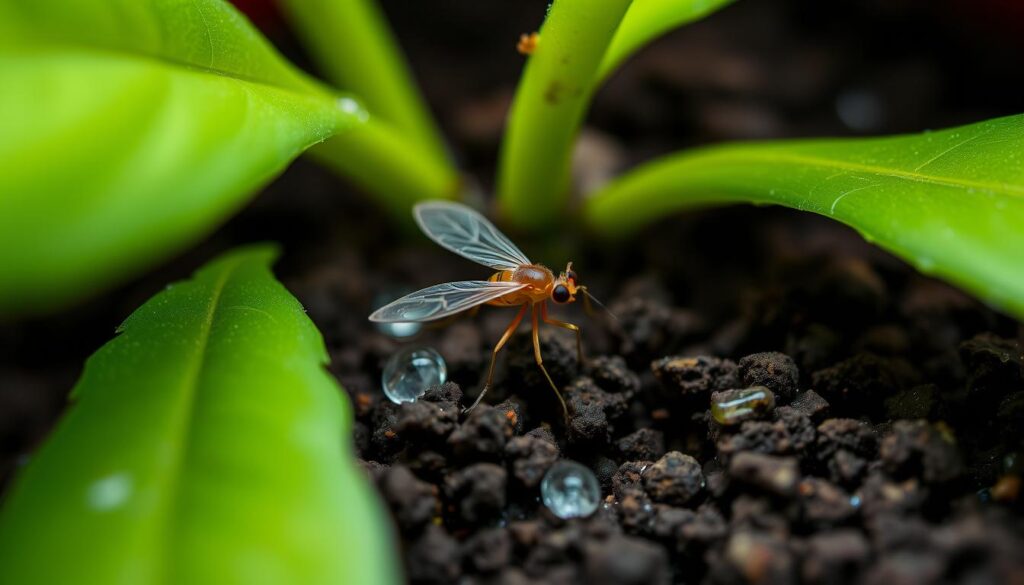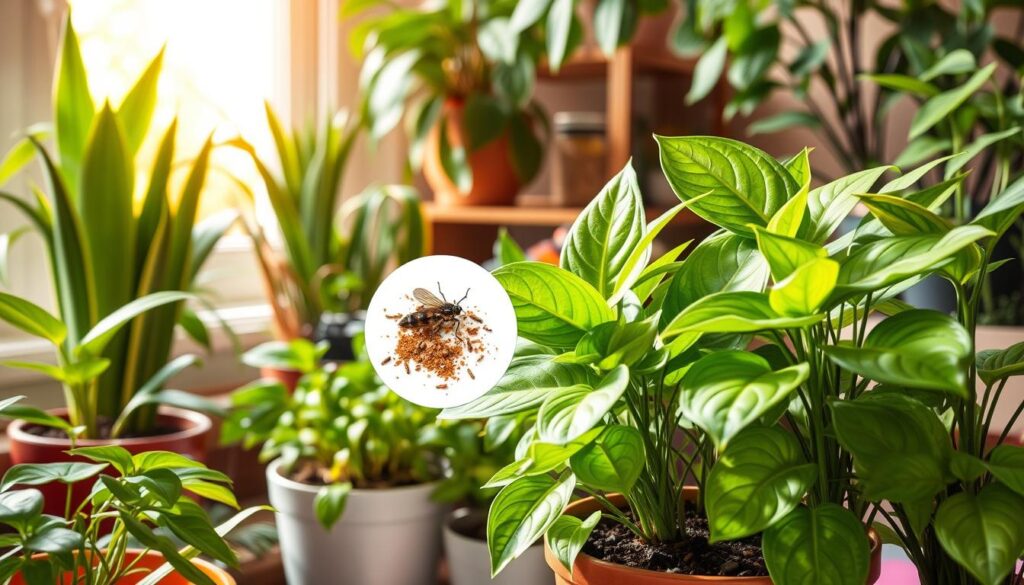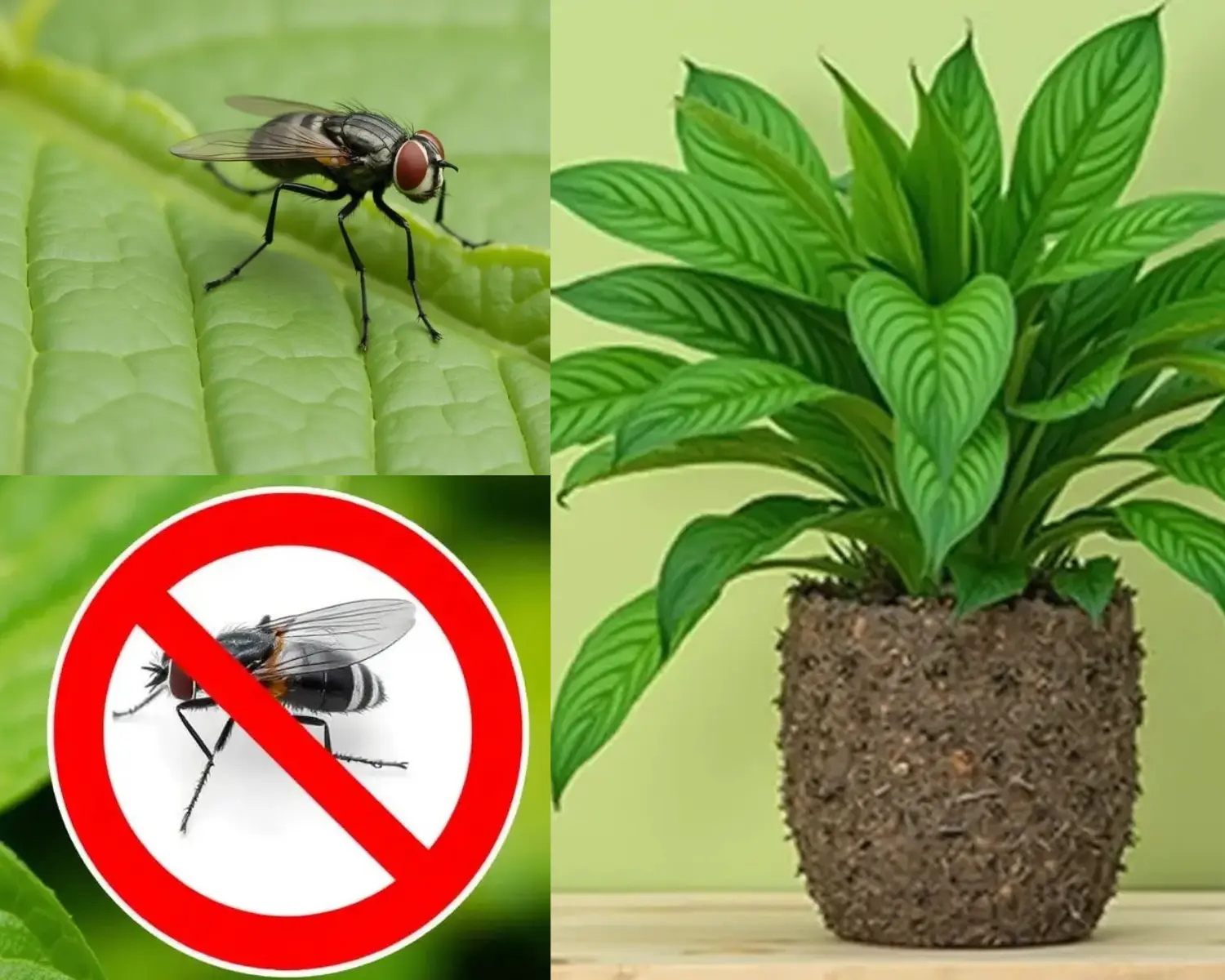how to get rid of house plant flies (fungus gnats)
As an indoor gardener, I’ve battled many challenges. But fungus gnats are the most frustrating. These tiny pests can turn your plants from lush to wilted. Seeing them buzz around your plants is heartbreaking.
But, there’s hope. This guide will show you fast ways to get rid of fungus gnats. You’ll learn how to make your indoor garden thrive again.

- Fungus gnats are a common pest that can quickly infest your indoor plants
- These pests can cause significant damage to your houseplants, leading to wilting, stunted growth, and even plant death
- Identifying the signs of fungus gnats and understanding their life cycle is crucial to effectively eliminating them
- A combination of organic and chemical treatment methods can help you get rid of fungus gnats fast
- Implementing preventative measures is key to keeping fungus gnats at bay and maintaining a healthy indoor garden
Understanding Fungus Gnats and Their Life Cycle
Fungus gnats are a common pest that can harm your houseplants. These tiny, flying insects are drawn to moist soil and organic matter in potted plants. Knowing their life cycle is key to eliminating fungus gnats and houseplant insect removal.
Identifying Fungus Gnats in Your Houseplants
Fungus gnats are small, dark flies with long legs and antennae. They are about 1/8 to 1/4 inch long. You’ll see them hovering over the soil or flying near your plants. The larvae, which damage plants, are white worms with black heads.
Why Fungus Gnats Appear in Indoor Plants
Fungus gnats are drawn to moist, nutrient-rich soil in potted plants. They lay their eggs there. The larvae feed on roots, decomposing organic matter and fungus, causing fungus gnat infestation and stunted growth.
The Damage Fungus Gnats Cause to Plants
Fungus gnats don’t directly kill plants, but their larvae can harm them. They feed on roots, causing wilting, yellowing leaves, and poor health. In bad cases, larvae can burrow into stems, causing plants to collapse.
| Life Cycle Stage | Duration | Description |
|---|---|---|
| Egg | 4-6 days | Tiny, white eggs laid in the soil near the plant’s roots |
| Larvae | 2-3 weeks | Translucent white worms that feed on plant roots and organic matter |
| Pupa | 4-6 days | Transitional stage where the larvae transform into adults |
| Adult | 10-30 days | Small, dark-colored flies that lay eggs and continue the cycle |
How to Get Rid of House Plant Flies (Fungus Gnats)
Are you dealing with houseplant bug problems from fungus gnats? These small, dark flies can quickly become a problem. They breed in the moist soil of your indoor plants. But, there are ways to get rid of soil gnats and keep your plants pest-free.
One quick fix is to reduce overwatering. Fungus gnats love damp conditions. So, letting the soil dry out between waterings can help stop their breeding.
- Watch your watering schedule closely. Water only when the top inch or two of soil feels dry.
- Use a soil moisture meter to find the right moisture level for your plants.
- Make the soil drain better by adding perlite or sand to your potting mix.
You can also set up traps to catch and kill adult fungus gnats. Simple options include yellow sticky cards. Or, you can try pheromone-based traps made for these pests.
By adding these steps to your houseplant care routine, you can get rid of soil gnats. This keeps your indoor plants healthy and growing well.

Natural and Chemical Treatment Methods for Fungus Gnat Control
There are many ways to get rid of fungus gnats in your indoor plants. You can use natural, organic methods or chemical treatments. The best choice depends on your situation. Let’s look at the options for controlling these pests.
Organic Solutions for Fungus Gnat Elimination
For a natural solution, consider using sticky traps to catch adult flies. Sprinkling diatomaceous earth around the soil can also work. It dehydrates and kills the larvae. Another option is introducing beneficial nematodes to the soil to disrupt the fungus gnat life cycle.
Chemical Treatments That Work
Chemical insecticides can also be effective against fungus gnats. Insecticidal soaps and pyrethrins target both adults and larvae. Always follow the instructions and take precautions to protect your plants and yourself.
Using Beneficial Nematodes
- Beneficial nematodes are a biological control measure that can be highly effective against fungus gnat larvae.
- These microscopic roundworms actively seek out and infect the larvae, ultimately killing them and breaking the pest’s life cycle.
- Applying beneficial nematodes to the soil around your indoor plants can provide long-lasting protection against fungus gnat infestations.

Knowing the different treatment methods helps you fight fungus gnat infestations in your indoor plants. Whether you choose natural or chemical treatments, acting fast and consistently is key. This way, you can keep your home and garden healthy and pest-free.
Prevention Strategies to Keep Fungus Gnats Away
Keeping your indoor plants healthy is key to avoiding fungus gnats. Make sure your potting soil drains well and isn’t too wet. Fungus gnats love moist soil, so don’t overwater. Let the soil dry a bit between waterings.
Using clean, quality potting mix is another smart move. Stay away from garden soil, as it can hide fungus gnat eggs and larvae. You can also add a thin layer of sand or fine gravel on top of the soil. This makes it hard for gnats to lay eggs.
It’s important to check your plants often and act fast if you see gnats. Look for small flies around the soil or larvae on the surface. If you find gnats, treat them quickly. Use organic or chemical methods to stop the problem before it gets worse.
FAQ
What are fungus gnats and why do they appear in my houseplants?
Fungus gnats are small, dark-colored flies that like moist soil in indoor plants. They breed in the soil, eating organic matter and plant roots. This can harm or kill your plants.
How can I identify a fungus gnat infestation in my indoor plants?
Look for small, winged insects flying or crawling on your plants’ soil. You might see larvae, which look like small, white worms. This is a sign of too much water in the soil.
What damage can fungus gnats cause to my houseplants?
Fungus gnats can harm your plants in many ways. The larvae eat plant roots, slowing growth and making plants sick. Adults spread fungi and bacteria, making plants even sicker.
How can I get rid of fungus gnats in my indoor plants?
To get rid of fungus gnats, you can use sticky traps, beneficial nematodes, or let the soil dry out. Insecticidal sprays or drenches can also help target these pests.
What are some natural and organic ways to control fungus gnats?
Natural ways to control fungus gnats include using diatomaceous earth, sprinkling cinnamon or sand on the soil, and introducing predatory insects. Proper watering and soil drainage can also prevent infestations.
How can I prevent future fungus gnat infestations in my houseplants?
To stop fungus gnats, use well-draining potting mix and avoid overwatering. Regularly check the soil for pests. Covering the soil with sand or gravel can also help. Keeping your growing area clean can also keep gnats away.

